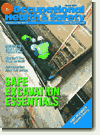
March 2006
- Safe Excavation Essentials
- Why Can't They Stand the Heat?
- Fall Protection: Know Your Netting
- A Guide to LOTO's 8 Critical Elements
Click here to subscribe.
Cover Story
By Stephen V. Magyar, Jr., MBA, CSP
CONSTRUCTION workers make up only 6 percent of the total workforce, but they are involved in more than 20 percent of all work-related fatalities. Trenching accidents that are directly related to excavation work account for almost 200 deaths annually.
Features
By Fred Elliott
OSHA's PPE standards and its handy eTool are the first stops to make when the question concerns eye and face protection. 29 CFR 1910.132 (general requirements), 1910.133 (general industry), 1915.153 (maritime), and 1926.102 (construction) say employers must ensure each affected employee uses appropriate eye or face protection when exposed to eye or face hazards from flying particles, molten metal, liquid chemicals, acids, caustic liquids, chemical gases or vapors, and potentially injurious light radiation.
By Ted Christensen, Steve Rupard
FALL protection equipment and training in the construction industry have come a long way in the past 50 years. Today, by law, any worker exposed to an unprotected fall of 6 feet or more must wear--and companies must provide--appropriate fall protection equipment.
By W. Jon Wallace, CSP, MBA
THE lockout/tagout standard--29 CFR 1910.147--is arguably the best OSHA standard ever written. For the price of a lock and tag, employees can be confident they are protected from the sudden release of hazardous energy while performing maintenance, cleaning, or servicing activities on equipment.
By Ray Booska
THERE are a ton of resources available from OSHA, NIOSH, medical associations, and the like explaining all of the signs of heat stress and what to do about them. You can easily get those online or with a simple phone call. Rather than rehashing those things here, I'm going to spend a couple of minutes talking to you about a few things you may not have considered regarding your employees.
By D. Jeff Burton, PE, CIH
THIS column provides information about the use of outdoor air dampers in hot and humid climates and during hot and humid seasons in temperate climates in commercial buildings.
By Dave Thomas
IN the construction industry, workers are consistently operating in environments where hazards abound. Employers and employees alike rely on state-of-the-art fall protection equipment as they work on various types of structures.
By Brad Witt
WE know the DuPonts and Fords can afford to maintain effective hearing conservation programs. But more than 99 percent of U.S. companies are defined as small businesses. They employ more than half of the U.S. workforce and are the dominant power in driving the economy. Small-business employers of noise-exposed workers can feel a real pinch in meeting OSHA's requirements for effective hearing conservation programs.
By Terry Byrd
SAFETY is a concern to all welding and cutting operations. Yet, for small to medium-sized welding facilities, managing the safety and health of workers can be a particular challenge. Unhealthy work environments can be costly to a welding shop.
By Stephen V. Magyar, Jr., MBA, CSP
THE attendant is the last individual external to the confined space who can monitor working conditions that will ensure the safety of the workers inside the work space. Attention to specific details outlined on the work permit, the ability to adequately oversee "permitted operations," and the authority to "stop work" when rules are violated are the critical elements of the responsibility.
By Dr. Shawn Adams, C.P.C.U., A.R.M., PHR, CHCM, Dr. Bill Lowe
IN the wake of a most devastating 2005 hurricane season with deadly storms named Katrina, Rita, and Wilma, many safety managers will undoubtedly find top management asking tough questions: "What are our risks and threats to customers, employees, operations and property? What type of enhancements to plant safety and emergency planning and response are justified?"
Departments
By Jerry Laws
IS H5N1 avian flu the real deal? Surprisingly, many Americans don't fear it. They may have taken comfort from Turkey's outbreaks early this year; the disease was fairly widespread there but, as of this writing, still could not be passed easily from person to person. Health care professionals are very worried, however.